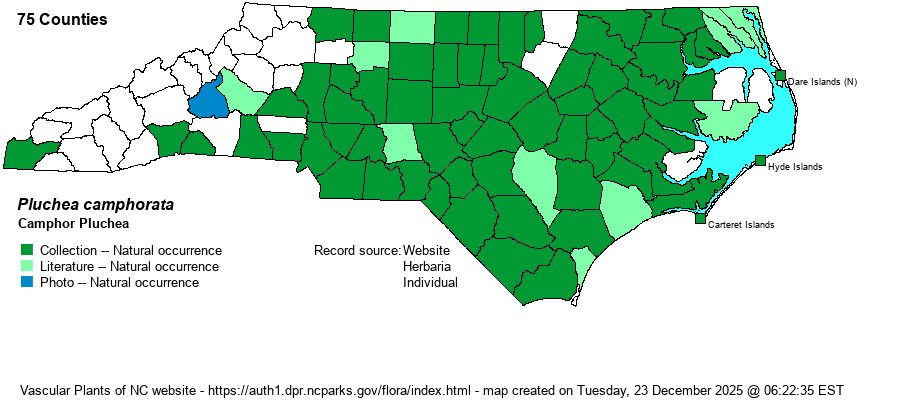| Author | (L.) de Candolle | |
| Distribution | Coastal Plain (including the Outer Banks), Sandhills, and Piedmont; disjunct in the southern Mountains to Cherokee County: shore of Lake Hiwassee.
DE to southern OH and KS, south to northern FL and TX. | |
| Abundance | Fairly common in most of the Piedmont and Coastal Plain; can be locally common. Rare in the foothills and in the far northeastern Coastal Plain; absent from most of the Mountains. This is essentially the only member of Pluchea that occurs in the Piedmont and Mountains. | |
| Habitat | Moist (periodically inundated) floodplains and bottomlands, openings in these habitats, freshwater marshes, fresh-tidal marshes, interdune marshes, shores of impoundments, roadside ditches. |
| Phenology | Flowering and fruiting August-October. | |
| Identification | Camphorweeds are leafy plants about 2 feet tall with relatively flat-topped inflorescences of pink, rosy, or dirty white heads. The vegetation has an unpleasant odor, often described as fetid. Camphor Pluchea has medium pink heads (disk florets only), the inflorescences are dome-shaped or rather rounded, and has distinctly stalked, ovate leaves. The other Pluchea with stalked leaves -- P. odorata -- grows mainly in salt to brackish habitats, has rather flat-topped inflorescences, has somewhat succulent leaves, and the heads are bright rosy in color. | |
| Taxonomic Comments | None
| |
| Other Common Name(s) | Camphorweed, Marsh Fleabane. As one can tell, no one has tried to standardize the common names of the Pluchea species, using a single group name and distinct modifier names. We are left with a mess! This website may coin the name of Common Camphorweed in upcoming months, as Camphor Pluchea is an awkward name, and genus names should be avoided in common names if at all possible. | |
| State Rank | S4 [S5] | |
| Global Rank | G5 | |
| State Status | | |
| US Status | | |
| USACE-agcp | FACW link |
| USACE-emp | FACW link |

